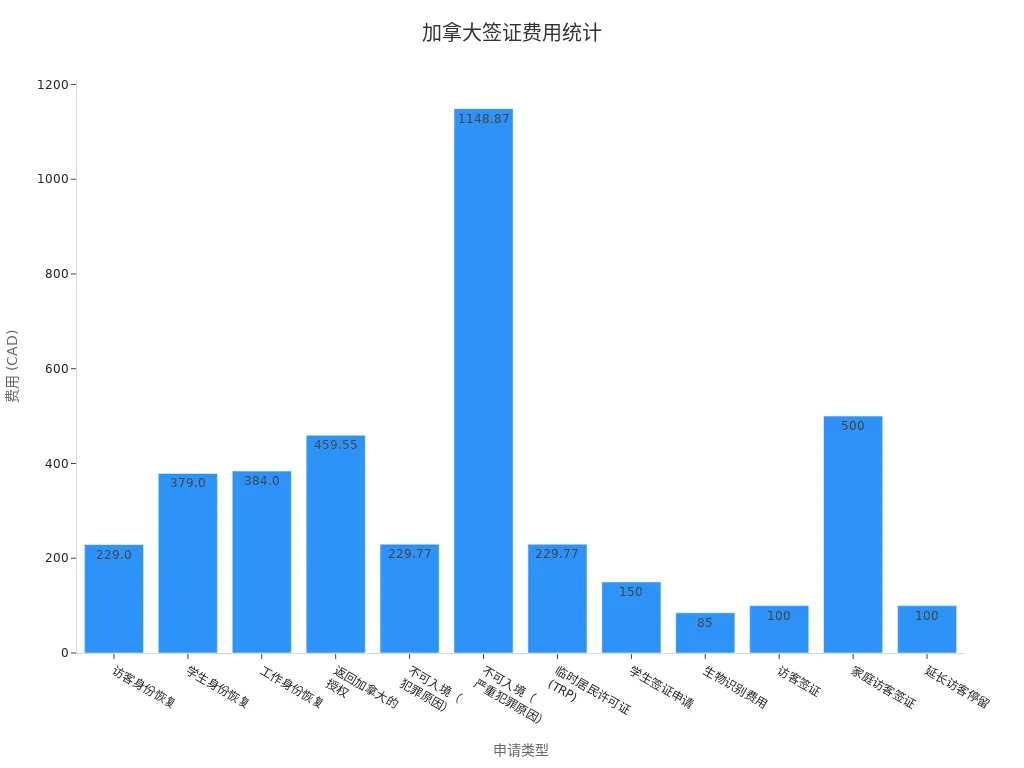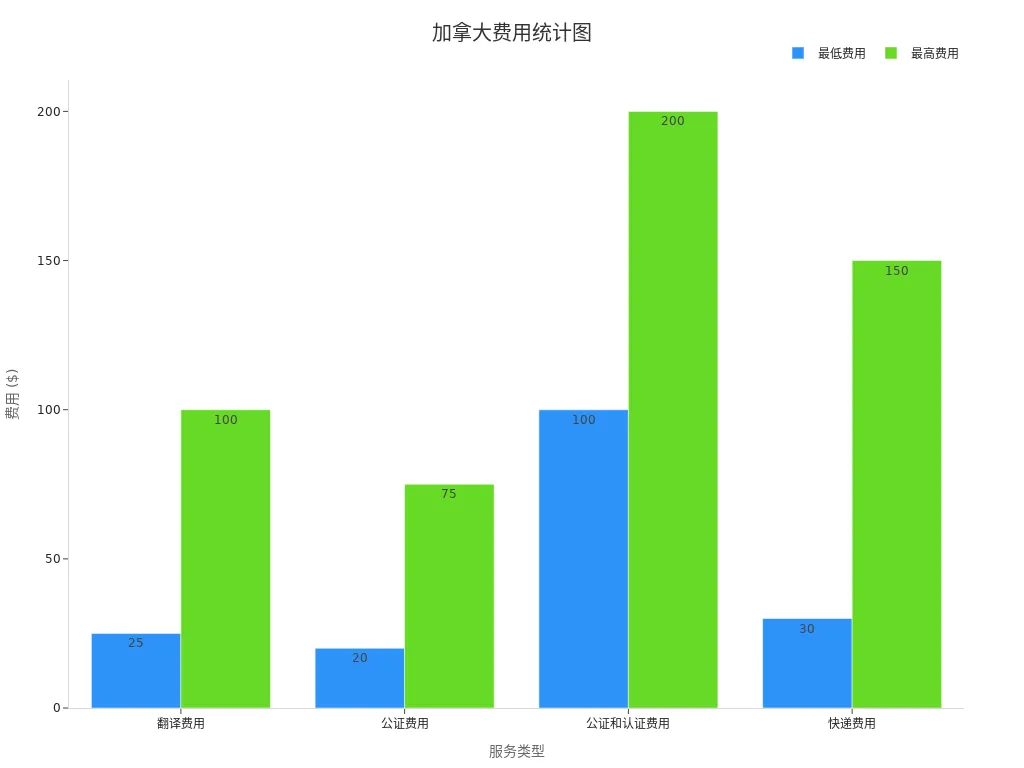2025 Canada Immigration Cost Saving Guide

Image Source: pexels
The cost of immigrating to Canada in 2025 continues to rise. According to the latest survey, 58% of Canadians believe the number of immigrants is too high, an increase of 14 percentage points compared to 2023. 65% of the public think the immigration targets are too high, exacerbating the housing shortage. These figures suggest that adjustments in immigration policies have made the cost of immigration more significant. In the face of these challenges, you need to adopt effective strategies to reduce unnecessary expenses and optimize the immigration process. Through proper planning, you can significantly reduce the overall cost of immigrating to Canada and keep your budget within control.
How Much Does It Cost to Immigrate to Canada? Key Expenses Breakdown
The cost of immigrating to Canada consists of several components. Understanding these costs can help you better plan your budget and avoid unnecessary spending.
Visa Application Fees
Visa application fees are one of the major expenses when immigrating to Canada. According to the latest statistics, the fees for different types of visas vary greatly. Below are some of the visa application fees:
| Application Type | Current Fee (CAD) |
|---|---|
| Visitor Record | $229.00 |
| Student Record | $379.00 |
| Work Record | $384.00 |
| Authorization to Return to Canada | $459.55 |
| Inadmissible (Criminal Cause) | $229.77 |
| Inadmissible (Serious Criminal Cause) | $1,148.87 |
| Temporary Resident Permit (TRP) | $229.77 |
| Student Visa Application | $150 |
| Biometrics Fee | $85 |
| Visitor Visa | $100 |
| Family Visitor Visa | $500 |
| Extend Visitor Stay | $100 |
In addition, visa fees are adjusted annually. For example, the fee for the Quebec Selection Certificate is expected to increase by 2.8% in 2025, from $822 to $845. The family sponsorship application fee also increased from $284 to $292. These changes require you to plan your budget in advance.

Language Test Fees
Language proficiency is one of the essential conditions for immigrating to Canada. You need to take an officially recognized language test, such as IELTS or CELPIP. The fees for these exams vary by region and test type. Below are the reference fees for some language tests:
| Test Name | Fee |
|---|---|
| Pearson Test of English (PTE) Core | N/A |
| Alberta Advantage Immigration Program (AAIP) Application Fee | $1,500 |
When selecting a language test, you can choose to participate based on your proficiency level. For instance, if you already have a high level of English or French, you can assess whether you need additional testing to save on costs.
Medical Exam and Report Fees
The immigration medical exam is an essential part of the application process. The exam fee typically ranges from $150 to $200, depending on the medical provider. Here are some key points regarding medical exam costs:
- Applicants under 15 or over 75 may have different fees.
- Additional visits or tests, if needed, are the applicant’s responsibility and are non-refundable.
- In some regions, the medical exam fee can be as high as $304.14.
It’s advisable to call several local civil surgeons to compare fees and ask if they accept immigration medical exam insurance. This method can help you find more cost-effective medical exam services.
Translation, Notarization, and Courier Fees
Translation, notarization, and courier fees are essential expenses during the immigration process. These fees typically vary depending on the number of documents, service types, and regions. By choosing service providers wisely, you can effectively reduce these costs.
Translation Fees
Immigration applications require a large number of documents, including birth certificates, educational credentials, and work experience certificates. If these documents are not in English or French, they need to be translated into the official language. Translation fees are typically charged per page, ranging from $25 to $100 per page. Choosing an experienced and reasonably priced translation agency can help save on costs.
Notarization Fees
Notarization is an important step to ensure the authenticity of documents. Notarization fees range from $20 to $75, depending on the document type and notarization requirements. If documents require further authentication, the fees may increase to $100 to $200. It’s advisable to learn about the specific notarization requirements in advance to avoid additional costs from repeated notarizations.
Courier Fees
During the immigration process, you may need to send documents to different agencies or government departments. Courier fees vary by distance and service type, typically ranging from $30 to $150. By choosing a reliable courier company, you can ensure the safe delivery of your documents and avoid additional expenses due to delays.
Here are the detailed data for translation, notarization, and courier fees:
| Service Type | Fee Range |
|---|---|
| Translation Fees | $25 to $100 per page |
| Notarization Fees | $20 to $75 |
| Notarization & Authentication Fees | $100 to $200 |
| Courier Fees | $30 to $150 |

Saving Tips
- Compare Multiple Providers: When choosing translation, notarization, and courier services, compare several providers to select the most cost-effective one.
- Consolidate Document Processing: Process all translation and notarization tasks at once to avoid extra costs from handling documents in batches.
- Choose Economy Shipping: For documents that do not require urgent delivery, opt for economy courier services to reduce transportation costs.
By following these methods, you can significantly reduce translation, notarization, and courier costs, thus lowering overall immigration expenses. Understanding the specific cost structure for immigrating to Canada and wisely planning each expense is key to achieving a low-cost immigration process.
Key Factors Influencing Immigration Costs
The cost of immigrating to Canada varies due to various factors. Understanding these key factors can help you better control your budget and avoid unnecessary spending.
Choosing the Right Immigration Program
Different immigration programs have significantly different cost requirements. Economic immigration programs, such as Express Entry, generally require higher application fees. In September 2024, the processing fee for Express Entry was $950 CAD, with a permanent residence fee of $575 CAD, totaling $1,525 CAD (for a single applicant). Family sponsorship programs tend to have lower fees, but may require additional financial proof.
Some programs also require applicants to pay extra fees, such as Educational Credential Assessments (ECA). For example, World Education Services (WES) charges a fee of $248 CAD. Choosing the immigration program that fits your qualifications can effectively lower overall costs.
Complexity of the Applicant’s Background
The complexity of an applicant’s background directly affects immigration costs. Here are some common hidden costs:
- Biometrics: $85 per person, $170 per family.
- Medical Exams: Fees range from $200 to $500.
- Certified Translation: $20 to $40 per page, depending on the document’s complexity.
- Proof of Funds: Applicants need to prove they have at least $20,635 CAD.
The more complex the background, the more documents and proofs are required, which increases costs. For example, the need for document translation and notarization may lead to additional expenses. Preparing all necessary materials in advance and ensuring their accuracy can reduce unnecessary costs.
Choosing a Migration Agency
Choosing a migration agency is an important factor affecting immigration costs. While fully entrusting the agency with the process is time-saving and convenient, it is more expensive. In contrast, handling part of the process yourself or selectively entrusting the agency with more complex tasks can significantly reduce costs.
When choosing an agency, you should pay attention to the following points:
- Valid Qualifications: Ensure the agency has legal qualifications to avoid low-cost traps.
- Transparent Services: Choose an agency with clear fees and no hidden charges.
- Reputation: Refer to reviews from other applicants to select a reputable agency.
By choosing the right agency, you can save money while ensuring a smooth immigration process.
How to Save Immigration Costs to Canada? Practical Tips

Image Source: pexels
Self-Application and Partial Delegation
The choice of how to handle the immigration process has a significant impact on costs. While fully delegating the process to an agency can save time and effort, it is expensive. In contrast, combining self-application with partial delegation can significantly reduce costs while ensuring the professionalism of key steps.
- Advantages of Self-Application:
You can obtain the latest policies and application guidelines from official immigration websites (such as the IRCC website). Preparing your materials and filling out forms on your own not only saves on agency fees but also helps you better understand the whole process. - Partial Delegation Strategy:
For complex steps (such as document review or legal advice), you can selectively delegate to professional agencies or lawyers. This approach reduces costs while avoiding the risk of rejection due to non-compliant materials.
Tip: When paying for agency fees, using cross-border payment platforms like BiyaPay can help you save on exchange rate differences and handling fees, ensuring that each payment is transparent and controlled.
Selective Participation in Language Exams
Language exams are an important part of the immigration application process, but not everyone needs to take multiple exams. Through reasonable planning, you can reduce unnecessary exam fees.
- Assess Your Language Proficiency:
If you already have a high level of English or French, you can assess your ability through a practice test. Many online platforms offer free IELTS or CELPIP practice tests to help you determine whether additional training is necessary. - Choose the Right Type of Exam:
Depending on the immigration program’s requirements, choose the most suitable language exam. For example, Express Entry accepts IELTS and CELPIP scores. If you are more confident in your speaking skills, CELPIP may be a better option since its speaking section is done through computer recording. - Avoid Re-taking Exams:
Before registering for an exam, make sure you are fully prepared. Purchasing official study materials or attending short-term training courses can increase your chances of passing, preventing the need for multiple attempts.
Tip: By using BiyaPay to pay for your language exam fees, you can enjoy lower exchange rates and complete the payment quickly, avoiding the failure of registration due to delayed payments.
Reasonably Plan for Medical Exams and Reports
Medical exams are an essential part of the immigration application, but their fees vary depending on the region and service provider. By planning ahead, you can save on these costs.
- Choose an Approved Medical Institution:
Immigration authorities designate approved medical exam centers worldwide. When scheduling an exam, prioritize selecting a nearby institution with lower costs. Understanding the pricing structure of each institution in advance can help avoid additional expenses due to information discrepancies. - Consolidate Medical Exam Requirements:
If your family members also require a medical exam, try to schedule them on the same day. This not only saves on transportation costs but also avoids the need for additional exams if the time gap is too long. - Check Insurance Coverage:
Some health insurance plans may cover part of the medical exam fees. Confirm with your insurance company before making an appointment to check if immigration medical exams are covered.
Recommendation: Use BiyaPay to pay for medical exam fees to avoid excessive cross-border payment fees while ensuring a secure and fast payment process.
By using these methods, you can effectively control the costs of language exams and medical exams during the immigration process. Proper planning at each step can not only save costs but also improve application efficiency.
Optimize Translation and Notarization Fees
Translation and notarization fees are inevitable expenses during the immigration process, but with reasonable planning, you can significantly reduce these costs. Here are some practical tips for optimization:
- Selective Translation of Documents
Not all documents need to be translated. You can prioritize translating necessary documents based on the specific requirements of your immigration program, such as birth certificates, educational certificates, and work experience certificates. For documents that are uncertain whether they need translation, consult the immigration authorities or a professional agency in advance to avoid unnecessary expenses. - Compare Prices and Choose the Best Translation Service
Translation fees vary between agencies. By comparing quotes and service quality from multiple translation agencies, you can choose a reasonably priced service with rich experience. Some agencies may offer discounts for bulk translations, further reducing costs by consolidating document processing. - Utilize Community Resources
Some immigrant communities or non-profit organizations may provide low-cost or even free translation services. You can join relevant immigration forums or social media groups to access these resources. - Avoid Repeating Translations
If you have already translated certain documents, check whether their validity period is still applicable. Most translated documents remain valid for a certain period, so avoiding unnecessary re-translation can save a significant amount of money.
Tip: Ensure the translation agency has certification qualifications, especially those recognized by immigration authorities. Non-certified translations may lead to application rejections, resulting in additional expenses.
Tips for Saving Notarization Fees
Notarization fees are usually calculated based on document type and quantity, but you can reduce these costs with the following methods:
- Understand Notarization Requirements in Advance
Different immigration programs have different notarization requirements. You can check the official guidelines or consult professionals to clarify which documents require notarization, avoiding unnecessary notarization steps. - Consolidate Notarization Tasks
Submit all documents that require notarization at once, which reduces time and fees for multiple visits. Some notary agencies may offer bulk discounts, making it more economical to handle all tasks at once. - Choose Economical Notarization Services
Notarization fees vary by region. You can select notary services in areas with lower costs. Make sure to make an appointment in advance and learn about the pricing structure to avoid paying extra fees due to a lack of information.
By following these methods, you can significantly optimize translation and notarization fees, ensuring your immigration budget is more reasonable.
Avoid Low-Cost Traps and Choose a Reputable Agency
For many applicants, choosing agency services is the first choice during the immigration process. However, low-cost agencies often hide many risks. Here are key suggestions for avoiding low-cost traps:
- Verify Agency Qualifications
Legitimate immigration agencies must hold certifications from the Canadian Immigration Consultants Regulatory Council (CICC). You can check the agency’s registration information on the CICC website to ensure its legality. - Beware of Extremely Low Quotes
If an agency’s quote is significantly lower than the market average, you need to be extra cautious. Low-cost agencies may compensate for costs by charging hidden fees or providing non-compliant services, leading to application failures or additional expenses. - Check Client Reviews
Through online platforms or social media, find reviews and feedback from other applicants about the agency. Choose an agency with a good reputation to reduce risks and improve service quality. - Sign a Transparent Contract
Before choosing an agency, ensure that both parties sign a written contract that clearly defines the services, fees, and refund policies. Avoid relying on verbal promises and ensure that all terms are clearly stated.
Caution: Some agencies may promise “guaranteed success” or “express pathways,” which are usually false claims. The Canadian immigration authorities have strict review standards, and any non-compliant actions will lead to rejection of your application.
How to Choose a Reputable Agency?
| Selection Criteria | Specific Requirements |
|---|---|
| Qualification Certification | Ensure the agency holds CICC certification and can be verified on the website. |
| Transparent Services | Clear fee structure with no hidden charges, providing a detailed service list. |
| Professional Experience | The agency should have rich immigration processing experience, especially with cases related to your program. |
| Customer Support | Provides timely communication and feedback, answering your questions and offering professional advice. |
By choosing a reputable agency, you can avoid low-cost traps and ensure a smooth immigration process. Proper planning and selecting service providers not only save costs but also improve the chances of a successful application.
2025 Low-Cost Immigration Programs Recommendations

Image Source: pexels
Programs Suitable for General Applicants
If your budget is limited, you may consider some low-cost immigration programs that are more accessible for ordinary applicants. These programs have lower financial requirements and simpler application processes. Below are a few recommended options:
- Express Entry
Express Entry is one of Canada’s main economic immigration pathways. It is suitable for applicants with work experience and language proficiency. You need to meet the minimum score requirements and submit an Educational Credential Assessment (ECA) and language test scores. While the application fee is relatively high, the overall cost is controllable, and the processing time is relatively short. - Provincial Nominee Programs (PNP)
Provincial Nominee Programs allow provinces to select immigrants based on their specific needs. Some provinces offer low-cost programs, such as the International Skilled Worker category in Saskatchewan. You can obtain a nomination through direct application or Express Entry’s PNP category to lower the overall costs. - Family Sponsorship Immigration
If you have relatives who are already Canadian permanent residents or citizens, you can apply through the family sponsorship program. This route has lower application fees and does not require a language test or financial proof. You just need to ensure that the sponsor meets the income requirements.
Tip: When choosing the immigration program that best fits your situation, make sure to carefully read the eligibility criteria to ensure you meet the requirements. Preparing all necessary documents in advance can help reduce additional expenses.
Low-Investment Immigration Categories
Some immigration categories have low investment requirements, making them ideal for applicants with a limited budget. Below are a few recommended low-investment immigration categories:
| Immigration Category | Investment Requirement | Suitable Candidates |
|---|---|---|
| Start-Up Visa | No minimum investment amount | Entrepreneurs with innovative business plans |
| Self-Employed Program | No proof of funds required | Professionals in cultural, artistic, or sports fields |
| Atlantic Immigration Program (AIP) | Employer offers a job opportunity, no extra investment required | Skilled workers and graduates who wish to settle in Atlantic provinces |
- Start-Up Visa
The Start-Up Visa is designed for applicants with innovative business ideas. You need support from a designated organization but no minimum investment amount is required. This program has low financial requirements and offers permanent residence. - Self-Employed Program
The Self-Employed Program is suitable for professionals working in the cultural, artistic, or sports fields. You only need to prove that you can be self-employed in Canada, with no proof of funds or employer sponsorship required. - Atlantic Immigration Program (AIP)
The Atlantic Immigration Program is for applicants who wish to settle in the Atlantic provinces such as Nova Scotia or Newfoundland and Labrador. Employers provide job offers, and there is no extra investment required. This program has lower financial requirements and simplified application procedures.
Suggestion: When choosing a low-investment immigration category, make sure your professional background and skills align with the program’s requirements. Contact relevant agencies or employers in advance to increase your chances of success.
By selecting the most suitable low-investment immigration program for your situation, you can save costs while ensuring you meet the eligibility criteria for a successful application.
Conclusion
Proper planning and obtaining accurate information are key to saving on immigration expenses. You need to select the most suitable immigration program and handling method according to your situation.
- Set a Clear Budget: Learn about the cost components in advance to avoid additional expenses due to lack of preparation.
- Optimize the Process: Combine self-application with professional services to save costs and ensure compliance with application requirements.
Tip: Don’t blindly pursue low-cost services. Choose reputable agencies and legal paths to ensure the smooth and lawful immigration process.
By planning scientifically and making rational decisions, you can achieve your goal of immigrating to Canada while controlling your budget.
FAQ
1. What documents do I need to prepare for immigration to Canada?
You will need to prepare documents such as your passport, birth certificate, educational certificates, work experience certificates, language test scores, and proof of funds. Ensure that all documents meet immigration requirements and complete translations and notarizations in advance. Consolidating the document process can save time and costs.
Tip: Check the validity of documents in advance to avoid delays caused by expired documents.
2. How do I choose the right immigration program for myself?
Choose the immigration program based on your professional background, language proficiency, and budget. Express Entry is suitable for skilled workers, Family Sponsorship is for those with relatives in Canada, and Start-Up Visa is for entrepreneurs with innovative business ideas. Carefully read the program requirements to ensure eligibility.
Suggestion: Use the immigration authority’s online tools to assess your eligibility.
3. What is the validity period of language test scores?
IELTS and CELPIP exam scores are valid for two years. Ensure you submit your application within the validity period to avoid retaking the test due to expired scores. Plan your exam timing in advance to ensure a smooth application process.
Note: Once the exam scores expire, they can no longer be used for immigration applications.
4. How do I avoid being scammed during the immigration process?
Choose a reputable agency and verify its qualifications. Be cautious of low-cost traps and avoid false promises like “guaranteed success” or “express pathways.” Sign a transparent contract that clearly defines the services, fees, and refund policies. Check the agency’s information on the immigration authority’s official website to ensure legitimacy.
Tip: Refer to other applicants’ reviews and choose a reputable service provider.
5. How long does the processing time for immigration to Canada take?
Processing times vary by program. Express Entry typically takes 6 to 12 months, while Family Sponsorship may take 12 to 24 months. Learn about the average processing time for your program in advance and plan your application steps accordingly to avoid delays due to time constraints.
Suggestion: Regularly check the immigration authority’s website for the latest processing time information.
*This article is provided for general information purposes and does not constitute legal, tax or other professional advice from BiyaPay or its subsidiaries and its affiliates, and it is not intended as a substitute for obtaining advice from a financial advisor or any other professional.
We make no representations, warranties or warranties, express or implied, as to the accuracy, completeness or timeliness of the contents of this publication.
Related Blogs of

Master US Stock Trading Hours in One Article: Never Miss Pre-Market and After-Hours Opportunities

US-China Trade War Enters New Phase: How the Tech Industry Can Respond to Supply Chain Impacts

How to Choose US Major Indices: Pros and Cons Analysis of S&P 500, Dow Jones, and Nasdaq

Micro Dow, Micro Nasdaq, Micro S&P Futures Comprehensive Comparison – Helping You Find the Best Trading Choice
Choose Country or Region to Read Local Blog
Contact Us
BIYA GLOBAL LLC is a licensed entity registered with the U.S. Securities and Exchange Commission (SEC No.: 802-127417); a certified member of the Financial Industry Regulatory Authority (FINRA) (Central Registration Depository CRD No.: 325027); regulated by the Financial Industry Regulatory Authority (FINRA) and the U.S. Securities and Exchange Commission (SEC).
BIYA GLOBAL LLC is registered with the Financial Crimes Enforcement Network (FinCEN), an agency under the U.S. Department of the Treasury, as a Money Services Business (MSB), with registration number 31000218637349, and regulated by the Financial Crimes Enforcement Network (FinCEN).
BIYA GLOBAL LIMITED is a registered Financial Service Provider (FSP) in New Zealand, with registration number FSP1007221, and is also a registered member of the Financial Services Complaints Limited (FSCL), an independent dispute resolution scheme in New Zealand.



















